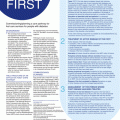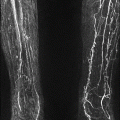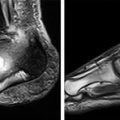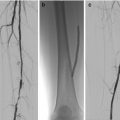Figure 10.1
Gastronemius muscle being placed below the tibialis anterior muscle flap (with its vascular pedicle)
Knee Disarticulation
Knee disarticulation is usually the preferred option, when compared to a transfemoral amputation, as it provides a better level of functioning, a better quality of life and possibly less phantom limb pain. Blood loss from this procedure is minimal and no tourniquet is required. The surgical technique, which avoids bone transection, is less of a physiological challenge and so is ideal for frail patients.
When designing the skin flaps, ensure that there is no skin loss around the circumference of the femoral condyles or there will be too much tension in the skin closure, with an increased risk of breakdown (Fig. 10.2).
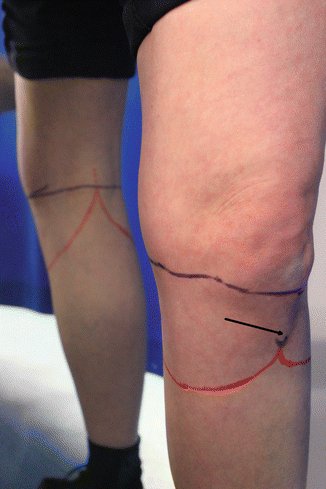

Figure 10.2
Design of medio-lateral flaps for knee disarticulation. Red line skin incision, black line joint of knee, arrow tibial tuberosity
Try and avoid a scar under the femoral condyles (weight bearing surface). Leave the patella in its usual anatomical position (though the underlying fat-pad can be removed to allow the patella ligament to be attached to the anterior cruciate ligament). It need not be removed as long as it does not impinge on the weight-bearing surface. Despite good wound healing from a Gritti-Stokes procedure, we think these are best avoided as the patella often becomes unstable, making the limb non-functional.
Synovial fluid leakage is a common problem and a suction drain should always be used. The drain should not be removed before a minimum of 5 days or after that when drainage is consistently less than 50 ml in 24 h. Wound complications are common in up to 25 % of patients, but can usually be dealt with simply.
Trans-femoral
This amputation will give a higher chance of healing but compromised mobility due to the extra energy needed to walk with an above knee prosthesis. The prosthesis extends up to the ischial tuberosity (the patient sits on it, like a bicycle saddle). It is thus uncomfortable to sit in a chair, as it has been designed for walking, and the patient may also need to remove the prosthesis to go to the lavatory.
Placing a sandbag under the ipsilateral buttock during surgery helps a balanced myodesis, by allowing access to the operative site with the hip in its neutral position. Posteriorly, the muscle implantation into the linea aspera of the femur should be stripped in the cranio-caudal direction and a haemostat clip works well for this (e.g. Dunhill).
When planning the flaps it is best to leave the stump as long as possible, although it is important to ensure that at least 12-cm clearance from the knee joint is achieved to allow for placement of the mechanical joint mechanism. The skin flaps should be loose (but not enough to develop skin folds) to allow for some retraction.
Myodesis of the patella tendon and adductor longus and biceps femoris muscles with the hip in a neutral position (parallel to the bed) is important. It creates a stronger residual limb, a good shape for fitting, keeps a mobile tissue covering over the bone and reduces the chances of lateral deviation of the femur. Without a myodesis of the adductor muscles, the residual limb will tend to abduct during ambulation, thus increasing the required effort for walking. The myodesis is achieved by drilling two holes in the end of the femur and fixing the adductors and hamstrings with a non-absorbable suture. Quadriceps femoris (patella tendon) is secured over the top of the stump to the posterior muscle group.
Shorter stumps will tend to develop fixed flexion (and abduction) contractures of the hip due to uncompensated action of the ilio-psoas muscle. The risk of this complication can be reduced by disconnecting the insertion of the tendon of this muscle from the lesser trochanter (especially if the patient has poor compliance, dementia or poorly controlled chronic pain). However, always try to leave the femoral head and trochanters in place to enhance sitting stability.
Stay updated, free articles. Join our Telegram channel

Full access? Get Clinical Tree



